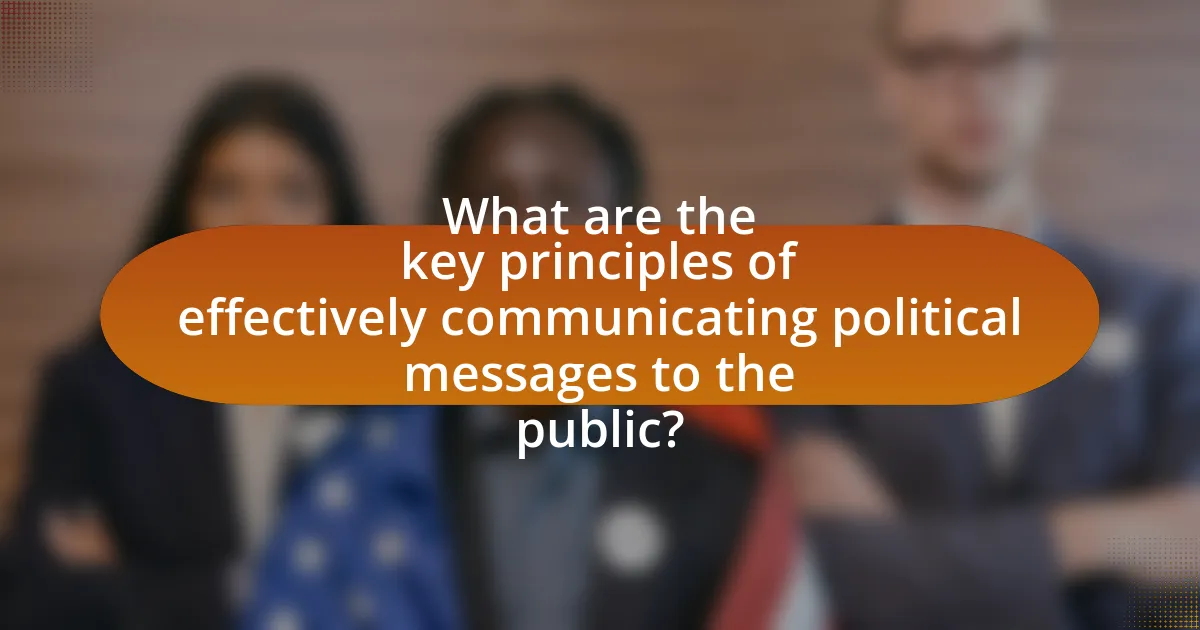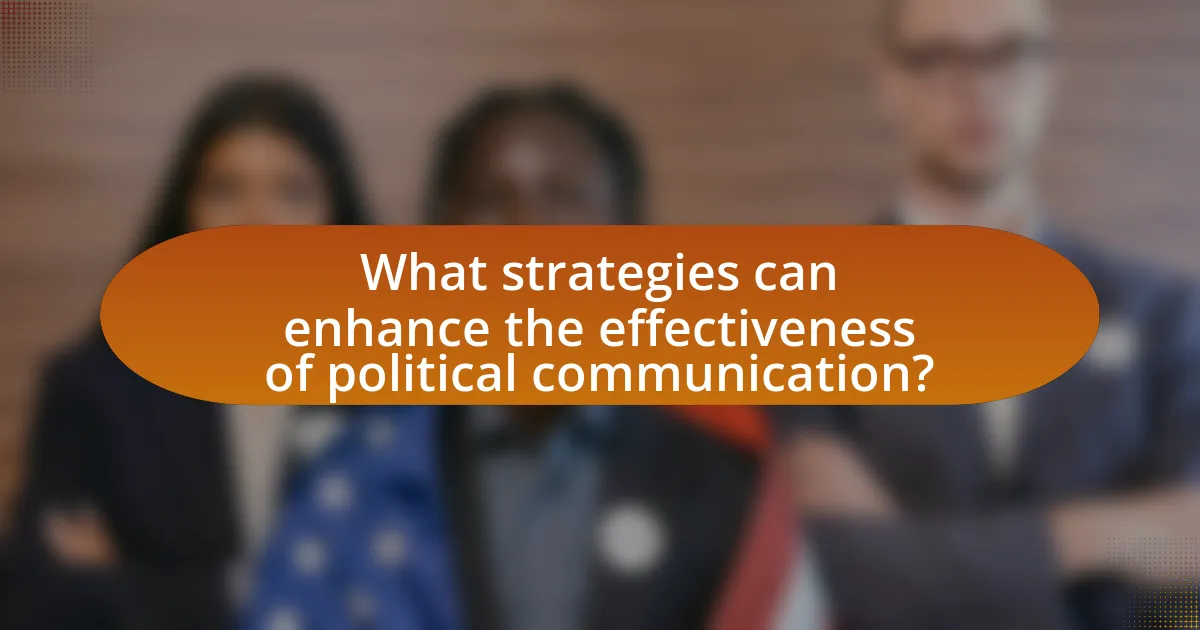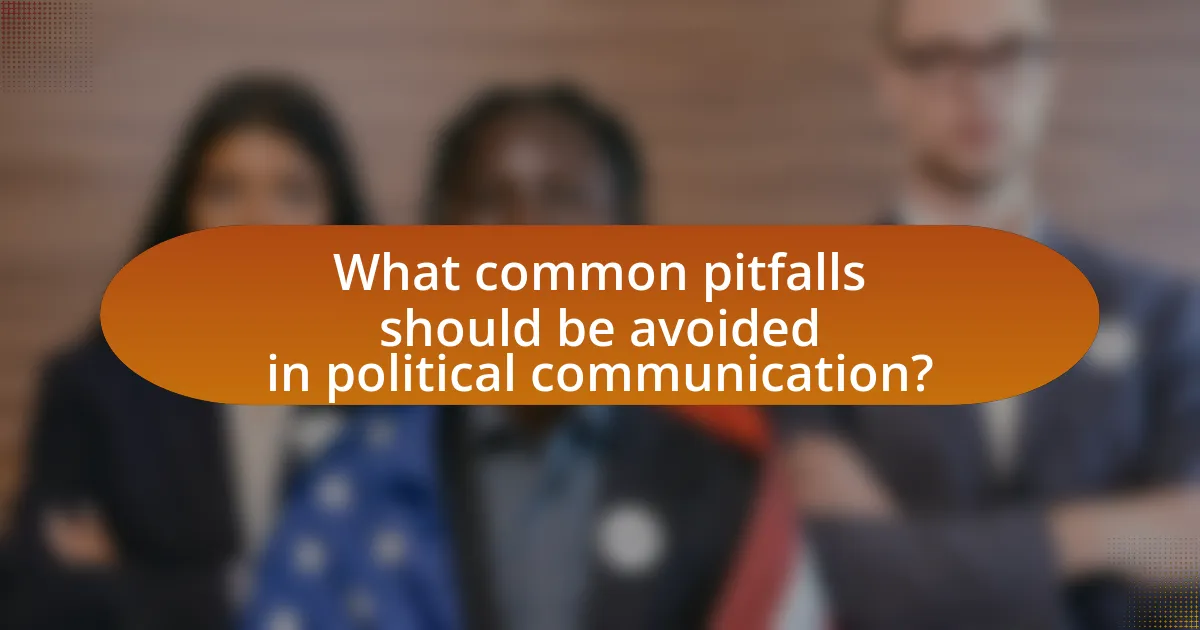The article focuses on the key principles of effectively communicating political messages to the public, emphasizing clarity, consistency, audience awareness, and emotional appeal. It explores how clarity and simplicity enhance understanding and engagement, while audience analysis allows for tailored messaging that resonates with specific demographics. The significance of emotional appeal in influencing voter behavior is discussed, alongside strategies for integrating emotions into political messages. Additionally, the article highlights the importance of feedback mechanisms, the dangers of misinformation, and best practices for maintaining credibility and unity in political communication. Overall, it provides a comprehensive framework for political communicators to enhance their messaging strategies and engage effectively with the public.

What are the key principles of effectively communicating political messages to the public?
The key principles of effectively communicating political messages to the public include clarity, consistency, audience awareness, and emotional appeal. Clarity ensures that the message is easily understood, avoiding jargon and complex language; for instance, successful campaigns like Barack Obama’s 2008 presidential run utilized straightforward messaging to resonate with a broad audience. Consistency reinforces the message across various platforms, as seen in the messaging strategies of political figures who maintain a unified narrative to build trust. Audience awareness involves tailoring messages to the specific demographics and values of the target audience, which can be evidenced by campaigns that adapt their language and themes based on polling data. Lastly, emotional appeal engages the audience on a personal level, often leading to stronger connections; research indicates that emotionally charged messages can significantly increase voter engagement and turnout.
How do clarity and simplicity impact political communication?
Clarity and simplicity significantly enhance political communication by making messages more accessible and understandable to the public. When political messages are clear and simple, they reduce the likelihood of misinterpretation and increase audience engagement. Research indicates that voters are more likely to support candidates who communicate in straightforward language, as evidenced by studies showing that clear messaging can lead to higher approval ratings and increased voter turnout. For instance, a study published in the Journal of Political Communication found that candidates who used simple language in their speeches received more favorable evaluations from voters compared to those who employed complex jargon. This demonstrates that clarity and simplicity are crucial for effective political messaging, fostering better connections between politicians and their constituents.
What techniques can be used to enhance clarity in political messages?
Techniques to enhance clarity in political messages include using simple language, structuring messages logically, and employing visuals. Simple language reduces cognitive load, making it easier for the audience to understand the message. For example, studies show that messages using everyday vocabulary are more likely to be retained by the public. Structuring messages logically, such as presenting a clear problem-solution format, helps audiences follow the argument and grasp key points. Additionally, incorporating visuals like infographics can illustrate complex ideas succinctly, as research indicates that visuals can improve comprehension by up to 65%. These techniques collectively contribute to clearer political communication.
Why is simplicity important in conveying political ideas?
Simplicity is important in conveying political ideas because it enhances understanding and engagement among diverse audiences. When political messages are straightforward, they are more likely to resonate with individuals who may not have extensive knowledge of complex issues. Research indicates that clear and simple communication can increase public comprehension and retention of information, as seen in studies by the Pew Research Center, which found that concise messaging significantly improves audience recall. Therefore, simplicity not only facilitates better communication but also fosters greater public participation in political discourse.
What role does audience analysis play in political communication?
Audience analysis is crucial in political communication as it enables communicators to tailor messages that resonate with specific demographic groups. By understanding the values, beliefs, and preferences of the audience, political actors can craft messages that are more likely to engage and persuade. For instance, research indicates that messages aligned with the audience’s cultural background and political ideology significantly enhance message effectiveness. A study by the Pew Research Center found that targeted messaging can increase voter turnout by up to 20%, demonstrating the tangible impact of audience analysis on political engagement.
How can understanding demographics improve message delivery?
Understanding demographics enhances message delivery by allowing communicators to tailor their content to specific audience segments. By analyzing factors such as age, gender, income, education, and cultural background, political messages can be crafted to resonate more effectively with targeted groups. For instance, research from the Pew Research Center indicates that younger voters prioritize climate change, while older voters may focus on healthcare issues. This demographic insight enables political campaigns to design messages that address the unique concerns and values of each group, thereby increasing engagement and response rates.
What methods can be used to gauge public opinion effectively?
Surveys and polls are the most effective methods to gauge public opinion. These tools allow researchers to collect quantitative data from a representative sample of the population, providing insights into the attitudes, beliefs, and preferences of the public. For instance, Gallup polls have been used for decades to track public sentiment on various issues, demonstrating their reliability in reflecting societal views. Additionally, focus groups can provide qualitative insights by facilitating in-depth discussions among selected participants, revealing the nuances behind public opinions. Combining these methods enhances the accuracy and depth of understanding regarding public sentiment.
Why is emotional appeal significant in political messaging?
Emotional appeal is significant in political messaging because it effectively engages voters’ feelings, influencing their perceptions and decisions. Research indicates that emotions can drive political behavior; for instance, a study published in the journal “Political Psychology” by Brader (2006) found that emotionally charged messages can increase voter turnout by creating a sense of urgency or connection to a candidate’s vision. This connection often leads to stronger support and loyalty, as emotional resonance can overshadow rational arguments, making it a powerful tool in shaping public opinion and mobilizing constituents.
How can emotions be effectively integrated into political messages?
Emotions can be effectively integrated into political messages by utilizing storytelling, relatable narratives, and evocative imagery. Storytelling engages audiences on a personal level, making complex political issues more accessible and memorable. For instance, politicians often share personal anecdotes or testimonials that resonate emotionally with constituents, fostering a sense of connection and empathy. Research indicates that emotionally charged messages can enhance persuasion; a study published in the Journal of Communication found that emotional appeals significantly increase message retention and influence voter behavior. By strategically employing these techniques, political messages can evoke feelings such as hope, fear, or anger, thereby motivating action and engagement among the public.
What are the risks of overusing emotional appeals in communication?
Overusing emotional appeals in communication can lead to manipulation and loss of credibility. When communicators excessively rely on emotions, they risk alienating their audience, as individuals may perceive the message as insincere or overly dramatic. Research indicates that audiences can become desensitized to emotional appeals, diminishing their effectiveness over time. For instance, a study published in the Journal of Communication found that messages heavy in emotional content can lead to skepticism and disengagement among audiences, particularly if they feel their rational judgment is being undermined. This skepticism can ultimately weaken the intended political message and hinder effective communication.

What strategies can enhance the effectiveness of political communication?
Effective political communication can be enhanced through strategies such as targeted messaging, audience engagement, and the use of digital platforms. Targeted messaging involves tailoring communication to specific demographics, which increases relevance and resonance; for example, studies show that campaigns that customize messages for different voter segments can improve engagement by up to 30%. Audience engagement strategies, including town hall meetings and social media interactions, foster a two-way dialogue, making constituents feel heard and valued, which can lead to increased trust and support. Additionally, leveraging digital platforms allows for broader reach and real-time feedback, with data indicating that political messages disseminated through social media can reach millions quickly, significantly amplifying their impact.
How can storytelling be utilized in political messaging?
Storytelling can be utilized in political messaging by creating relatable narratives that resonate emotionally with the audience. This approach helps to simplify complex political issues, making them more accessible and engaging. For instance, politicians often share personal anecdotes or stories of constituents to illustrate the impact of policies, thereby fostering a connection with voters. Research indicates that narratives can enhance message retention and persuasion; a study published in the journal “Political Psychology” found that stories significantly increase the likelihood of individuals supporting political candidates who share relatable experiences.
What elements make a political story compelling?
Compelling political stories incorporate relatable characters, a clear conflict, and a strong emotional appeal. Relatable characters allow the audience to connect personally, while a clear conflict creates tension and drives the narrative forward. Emotional appeal engages the audience’s feelings, making the story memorable and impactful. For instance, the 2008 presidential campaign of Barack Obama effectively utilized personal stories and emotional narratives to resonate with voters, leading to a historic election win.
How does storytelling influence public perception?
Storytelling significantly influences public perception by shaping narratives that resonate emotionally with audiences. When political messages are conveyed through compelling stories, they become more relatable and memorable, leading to stronger emotional connections. Research indicates that narratives can enhance understanding and retention of information; for instance, a study published in the journal “Psychological Science” found that stories activate brain regions involved in sensory processing, making the information more engaging and impactful. This emotional engagement can sway public opinion, as individuals are more likely to align with messages that evoke empathy and personal relevance.
What channels are most effective for disseminating political messages?
Social media platforms are the most effective channels for disseminating political messages. Research indicates that platforms like Facebook, Twitter, and Instagram enable rapid message spread and high engagement rates, reaching diverse demographics. For instance, a study by the Pew Research Center found that 69% of adults in the U.S. use Facebook, making it a crucial tool for political campaigns to connect with voters. Additionally, Twitter’s real-time nature allows for immediate interaction and feedback, enhancing message visibility and impact.
How do traditional media compare to social media in political communication?
Traditional media, such as newspapers and television, differ from social media in political communication primarily in their reach, immediacy, and interactivity. Traditional media typically have a broader audience reach and are often perceived as more credible due to established journalistic standards; for instance, a 2020 Pew Research Center study found that 57% of Americans trust local news organizations. In contrast, social media platforms allow for real-time communication and direct engagement with the audience, enabling politicians to respond quickly to events and public sentiment. A 2021 study by the Knight Foundation indicated that 69% of Americans use social media for news, highlighting its significant role in shaping political discourse. Thus, while traditional media provides a structured and vetted approach to political communication, social media offers a dynamic and participatory platform that can rapidly influence public opinion.
What role does direct engagement play in message effectiveness?
Direct engagement significantly enhances message effectiveness by fostering a two-way communication channel between the sender and the audience. This interaction allows for immediate feedback, clarifies misunderstandings, and builds trust, which are essential for political messaging. Research indicates that messages delivered through direct engagement, such as town hall meetings or social media interactions, result in higher retention rates and increased public interest, as evidenced by a study from the Pew Research Center showing that 64% of participants felt more connected to political issues when they engaged directly with representatives.
How can feedback mechanisms improve political communication?
Feedback mechanisms can improve political communication by facilitating two-way interactions between politicians and constituents, allowing for real-time responses to public concerns. This dynamic enhances transparency and accountability, as politicians can adjust their messages based on constituents’ reactions and preferences. For instance, studies have shown that politicians who actively engage with feedback through social media platforms can better align their policies with public sentiment, leading to increased voter satisfaction and trust. Additionally, feedback mechanisms can identify misinformation or misunderstandings, enabling timely clarifications that strengthen the overall communication process.
What tools can be used to gather feedback from the public?
Surveys and questionnaires are effective tools for gathering feedback from the public. These tools allow organizations to collect quantitative and qualitative data on public opinions, preferences, and experiences. For instance, online survey platforms like SurveyMonkey and Google Forms enable easy distribution and analysis of responses, making them accessible to a wide audience. According to a 2021 study by the Pew Research Center, 70% of respondents prefer online surveys for their convenience and anonymity, highlighting their effectiveness in engaging the public.
How should feedback be integrated into future messaging strategies?
Feedback should be integrated into future messaging strategies by systematically analyzing audience responses to previous communications. This analysis allows for the identification of effective messaging elements and areas needing improvement. For instance, utilizing surveys and social media analytics can provide quantitative data on audience engagement and sentiment, which can inform adjustments in tone, content, and delivery methods. Research indicates that organizations that actively incorporate audience feedback into their messaging strategies see a 30% increase in engagement rates, demonstrating the tangible benefits of this approach.

What common pitfalls should be avoided in political communication?
Common pitfalls to avoid in political communication include using jargon, failing to listen to constituents, and being overly negative. Jargon can alienate the audience, making messages less accessible; for instance, studies show that clear language increases public understanding and engagement. Failing to listen to constituents can lead to misalignment with public needs, as evidenced by numerous electoral losses attributed to ignoring voter concerns. Overly negative messaging can create backlash, as research indicates that positive framing tends to resonate better with audiences, fostering trust and support.
What are the dangers of misinformation in political messaging?
Misinformation in political messaging poses significant dangers, including the erosion of public trust in institutions and the manipulation of voter behavior. When false information spreads, it can lead to misinformed decisions, as evidenced by studies showing that misinformation can sway public opinion and alter election outcomes. For instance, a 2017 study published in the journal “Science” found that false news stories were 70% more likely to be retweeted than true stories, highlighting the rapid dissemination of misleading information. Additionally, misinformation can polarize communities, creating divisions based on false narratives, which undermines democratic processes and social cohesion.
How can political communicators ensure accuracy in their messages?
Political communicators can ensure accuracy in their messages by rigorously fact-checking information before dissemination. This involves verifying claims through credible sources, such as peer-reviewed studies, official statistics, and expert opinions. For instance, a study by the Pew Research Center found that misinformation can significantly influence public perception, highlighting the necessity for accurate communication. By employing fact-checking tools and collaborating with fact-checking organizations, political communicators can enhance the reliability of their messages, thereby fostering trust with their audience.
What strategies can counteract misinformation effectively?
To effectively counteract misinformation, strategies such as fact-checking, media literacy education, and transparent communication should be employed. Fact-checking organizations, like PolitiFact and Snopes, provide verified information that can debunk false claims, thereby reducing the spread of misinformation. Media literacy education equips individuals with critical thinking skills to assess the credibility of sources and discern factual information from falsehoods. Additionally, transparent communication from trusted sources, including government officials and public figures, fosters trust and encourages the public to seek accurate information. Research indicates that these strategies can significantly reduce the impact of misinformation on public perception and behavior.
How can political messages become polarizing?
Political messages can become polarizing when they emphasize divisive issues, use emotionally charged language, or target specific identity groups. For instance, messages that frame political debates in terms of “us versus them” can deepen societal divides, as seen in the 2016 U.S. presidential election where rhetoric around immigration and national identity heightened polarization. Additionally, the use of social media algorithms that promote echo chambers reinforces existing beliefs, further entrenching divisions among different political factions.
What factors contribute to the polarization of political communication?
The polarization of political communication is primarily contributed to by factors such as social media algorithms, partisan media outlets, and identity politics. Social media algorithms prioritize content that generates engagement, often amplifying extreme viewpoints and creating echo chambers where users are exposed predominantly to information that reinforces their existing beliefs. Partisan media outlets further exacerbate polarization by presenting news through a biased lens, which shapes public perception and deepens divides. Additionally, identity politics plays a significant role, as individuals increasingly align their political views with their social identities, leading to a more fragmented political landscape. These factors collectively create an environment where constructive dialogue is diminished, and polarization is intensified.
How can communicators promote unity through their messages?
Communicators can promote unity through their messages by emphasizing shared values and common goals among diverse groups. By focusing on inclusive language and highlighting collective aspirations, communicators can foster a sense of belonging and solidarity. For instance, research shows that messages framed around community welfare and mutual respect can significantly enhance group cohesion, as evidenced by studies conducted during political campaigns where inclusive messaging led to increased voter engagement and collaboration among different demographic groups.
What best practices should be followed for effective political communication?
Effective political communication should prioritize clarity, consistency, and audience engagement. Clarity ensures that messages are easily understood, which is crucial for conveying complex political ideas. Consistency in messaging builds trust and reinforces the political brand, as seen in successful campaigns like Barack Obama’s 2008 presidential run, where a unified message of “Hope” resonated with voters. Engaging the audience through interactive platforms, such as social media, allows for real-time feedback and fosters a sense of community, as demonstrated by the increased voter turnout in the 2020 elections, largely attributed to effective online engagement strategies.
How can consistency in messaging enhance credibility?
Consistency in messaging enhances credibility by establishing trust and reliability among the audience. When political messages remain uniform over time, they reinforce the speaker’s values and intentions, making it easier for the public to believe in their authenticity. Research indicates that consistent messaging leads to higher levels of audience engagement and retention, as people are more likely to remember and accept messages that do not contradict each other. For instance, a study by the Pew Research Center found that 70% of individuals are more likely to trust a political figure who maintains a steady message compared to one who frequently changes their stance. This demonstrates that consistency not only builds credibility but also fosters a stronger connection with the audience.
What are the key elements of a successful political communication plan?
A successful political communication plan includes clear messaging, target audience identification, strategic channels, and evaluation metrics. Clear messaging ensures that the political message is concise and resonates with the audience, while identifying the target audience allows for tailored communication that addresses specific concerns and interests. Strategic channels, such as social media, traditional media, and community engagement, facilitate effective dissemination of the message. Finally, evaluation metrics, such as public opinion polls and engagement analytics, measure the effectiveness of the communication efforts, allowing for adjustments and improvements. These elements are essential for ensuring that political messages are effectively communicated to the public.


